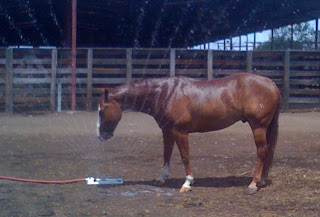Someone sent this to me in an email, and I wish I knew who to give credit for these lyrics because I think they are great. Enjoy!Sung to the tune of Janis Joplin's "O Lord Won't You Buy Me a Mercedes Benz"Oh Lord won't you buy me a horsey that bends
My friends all ride warmbloods, I must make amends
I practice my leg yields each evening 'til ten
Oh Lord, won't you buy me a horsey that bends
Oh Lord, won't you buy me a horse that won't buck
I'm tired of trying to land standing up
I spend all my time brushing dirt off my butt
Oh Lord won't you buy me a horse that don't buck
Oh Lord, won't you buy me a horse that won't bite
I count all my fingers and toes every night
I feel like a carrot when I'm in his sight
Oh Lord won't you buy me a horse that won't bite
Oh Lord, won't you buy me a horse that stays clean
I brush him, I groom him, I've considered chlorine
His colour's too chestnut for a horse with grey genes
Oh Lord won't you buy me a horse that stays clean
Oh Lord won't you buy me a horse with some guts
This spooking and shying is driving me nuts
And while you are at it make me less of a klutz
Oh Lord, won't you buy me a horse with some guts
Oh Lord, won't you give him some hindquarter drive
This horse is soooo lazy, not sure he's alive
We bend and we circle 'til way way past five
Oh Lord won't you give him some hindquarter drive
Oh Lord, won't you give me a mule that gaits well
No trotting, no pacing...he four beats like h***
Lop eared and no withered; man it'd be swell
Oh Lord if you'd give me a mule that gaits well
Oh Lord, won't you give me a mare with a brain
One that keeps working when hormones are strained
The gelding's in therapy, the stallion is drained,
Oh Lord won't you give me a mare with a brain
Oh Lord won't you buy me a horse that don't eat
No grass or no hay, now that would be neat
No rain means no pasture, my wish I'll repeat
Oh Lord won't you give me a horse that don't eat
Oh Lord, won't you give me a horse with no bills
My vet and my farrier are first in my will
Work hard all day long just to pay for his pills
Oh Lord, won't you give me a horse with no bills
Oh Lord-please-make his IQ just a 3
The horse I got now thinks he's smarter than me
Well, he doesn't just think it, he's right, don't you see
Oh Lord-PLEASE-make his IQ just a 3
Oh Lord, won't you buy me a horse with some spots
I'm bored with the bay ones and chestnuts and such
Leopards or snow flakes or peacocks with socks
Oh Lord won't you buy me a horse with some spots
Oh Lord, won't you buy me a horse with good feet?
No head bob or hip hitch, no screwed up right lead
I could finally ride more than I soak, wrap and knead
Oh Lord, my achin' backside would rejoice, INDEED
Oh Lord won't you buy me a horse with a saw?
One who can measure and manage an awl
A horse that can eyeball and set a post straight;
drill holes, screw hinges and hang a tube gate
Oh Lord, won't you buy me a horse with good tools?
These crooked fences make us all look like fools!
Oh Lord, won't you buy me a saddle that fits
My arse is so tender I can't hardly sit
Something soft to my tushy and wide for his back
Maybe deep seated, cushioned and in shiny black
Ooooh, Lord, won't you buy me a saddle that fits

 Every year, I put together some wacky Christmas card that involves my animals. But the picture I took of my pony Jackie, wrapped in Christmas lights, is by far my favorite! She was a very patient and quite bombproof pony, who would stand anywhere for some food. Some Equine Senior in the snow was all it took to get this one done. My husband also came up with the greatest byline for this photo, "Redneck Electric Fence!" Although Jackie is sadly no longer with us, she lives on in our Christmas memories and in the hearts of the many kids she gave pony rides to.
Every year, I put together some wacky Christmas card that involves my animals. But the picture I took of my pony Jackie, wrapped in Christmas lights, is by far my favorite! She was a very patient and quite bombproof pony, who would stand anywhere for some food. Some Equine Senior in the snow was all it took to get this one done. My husband also came up with the greatest byline for this photo, "Redneck Electric Fence!" Although Jackie is sadly no longer with us, she lives on in our Christmas memories and in the hearts of the many kids she gave pony rides to. 










































